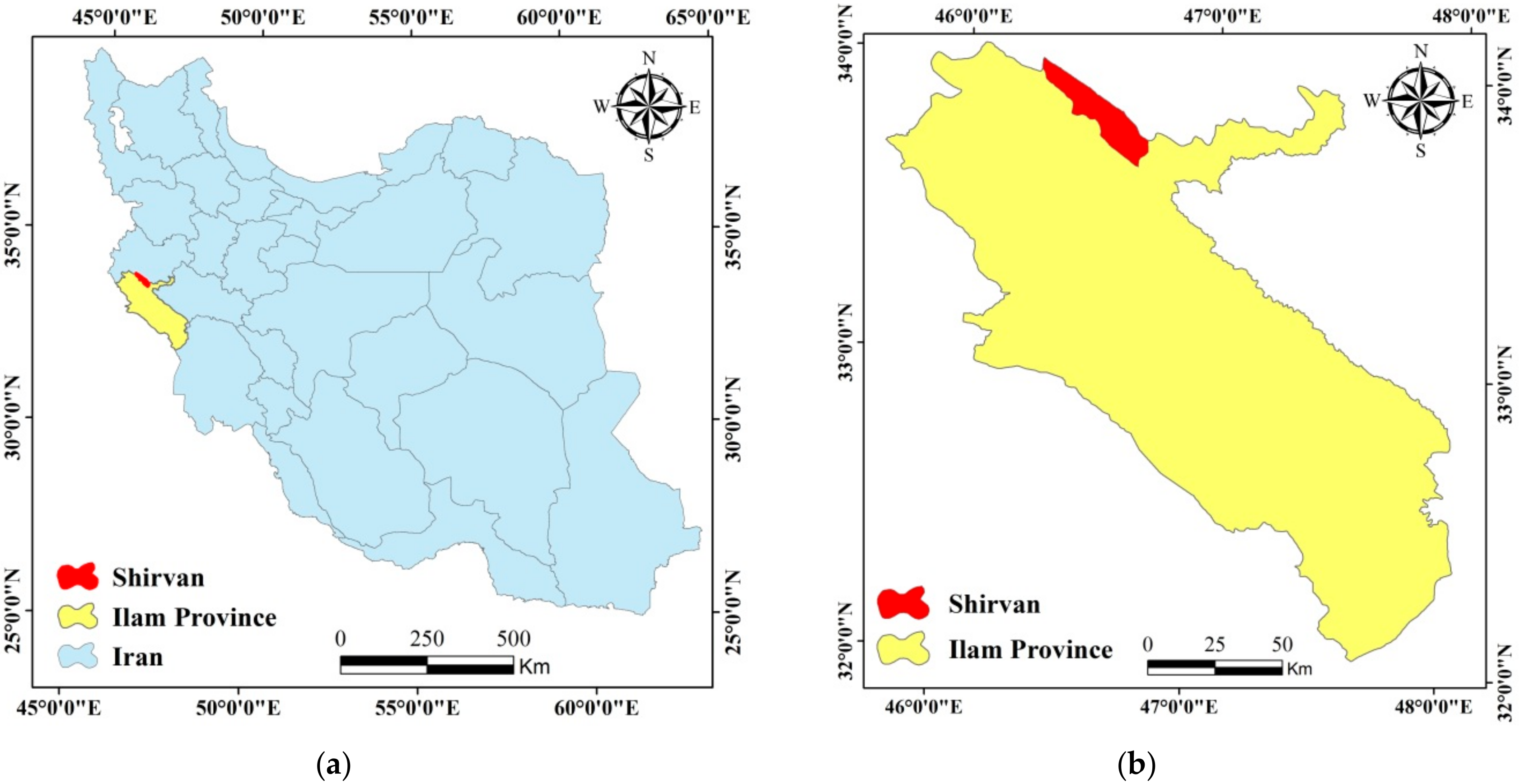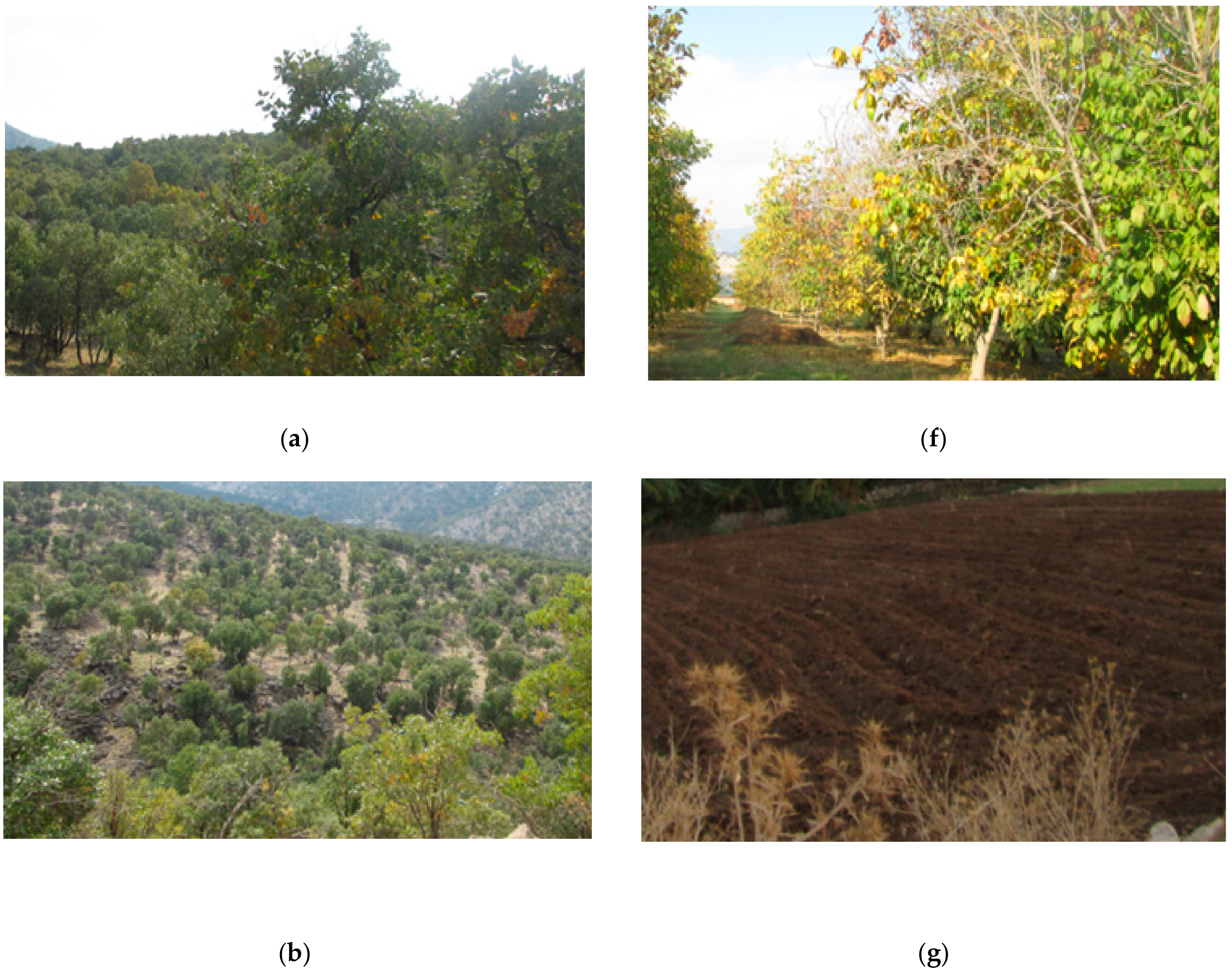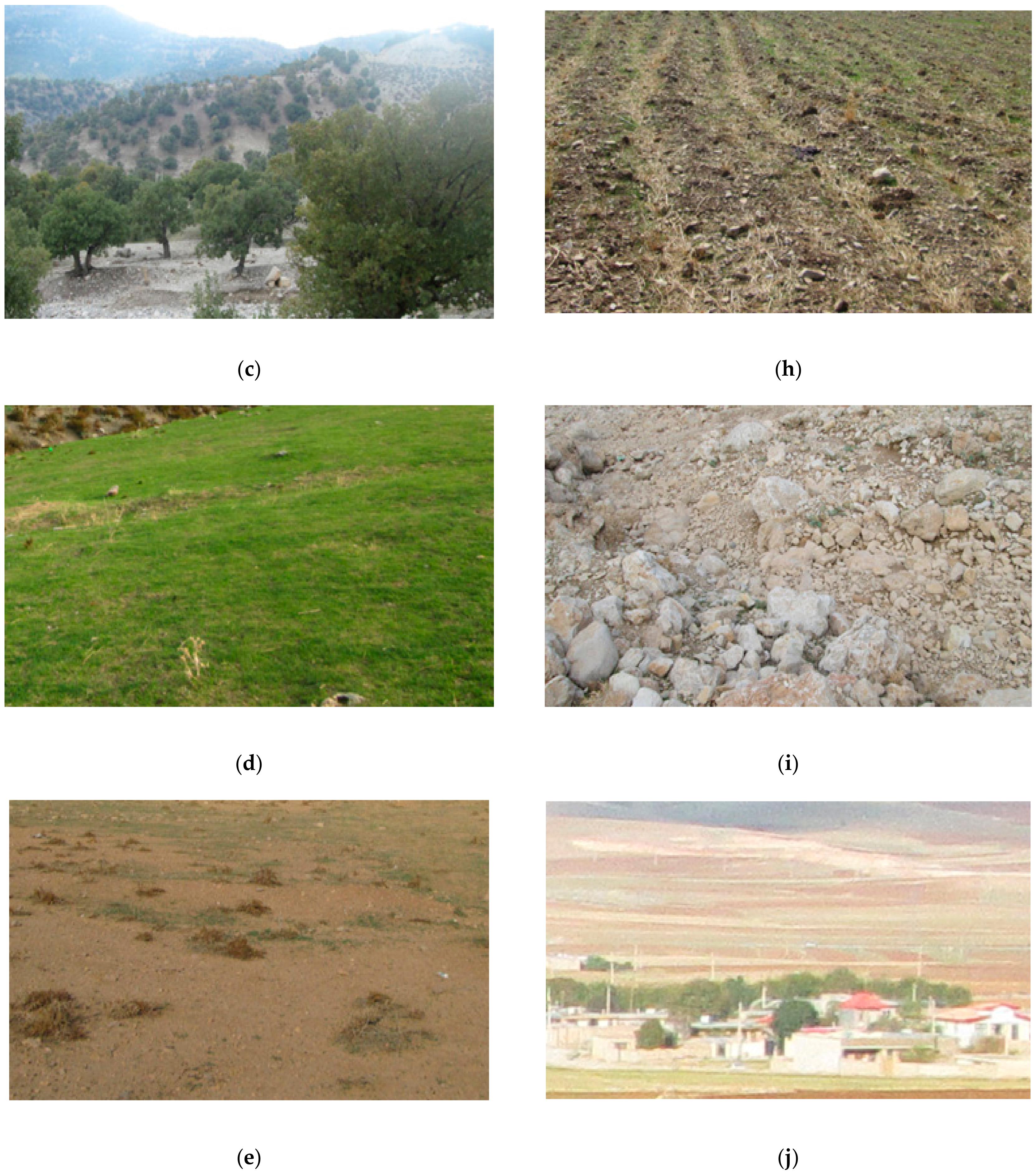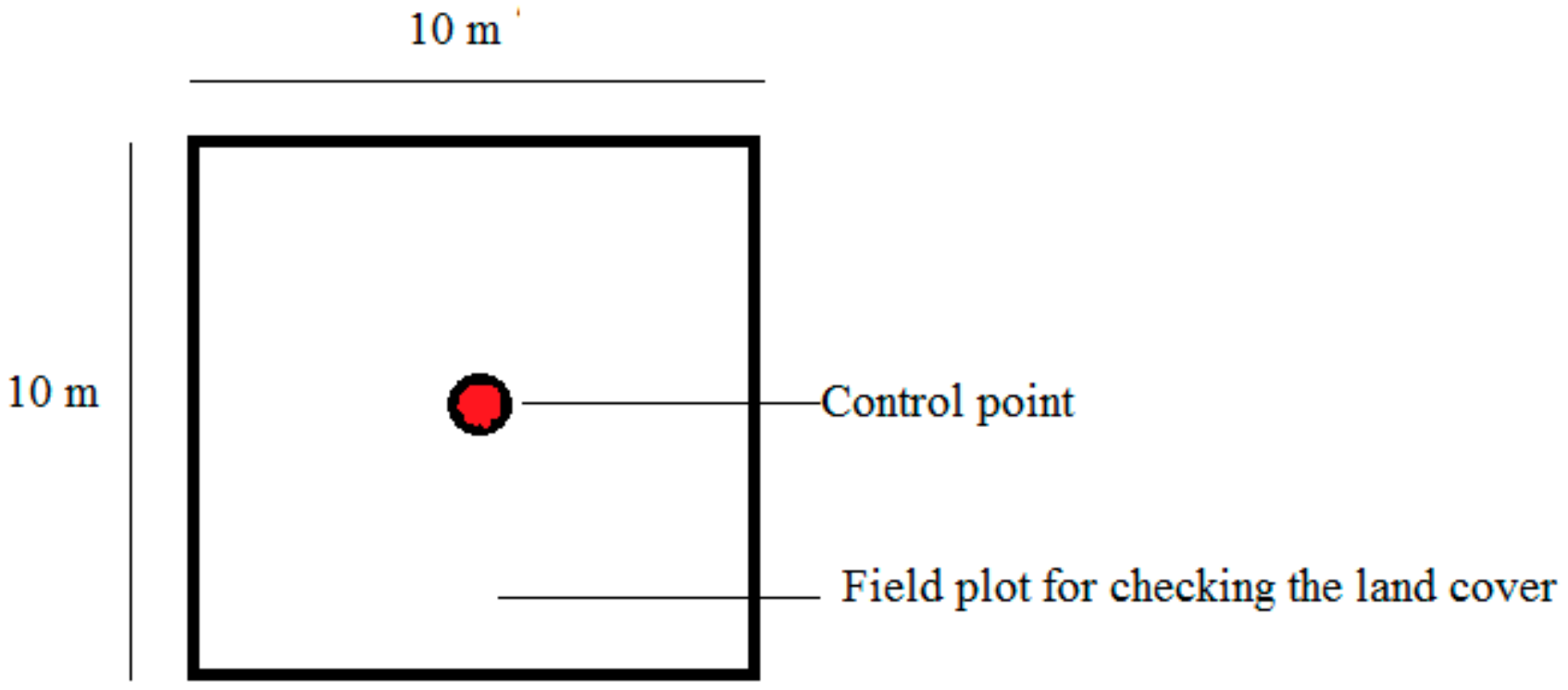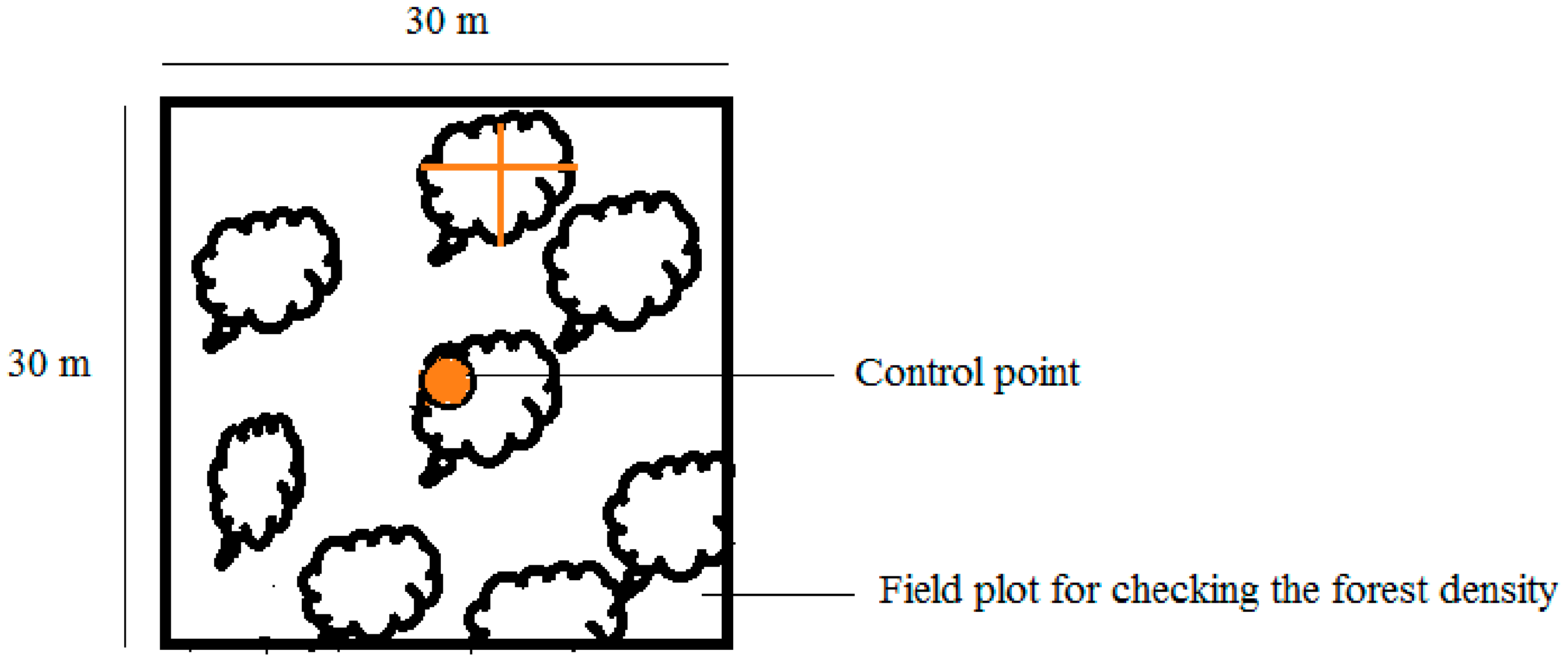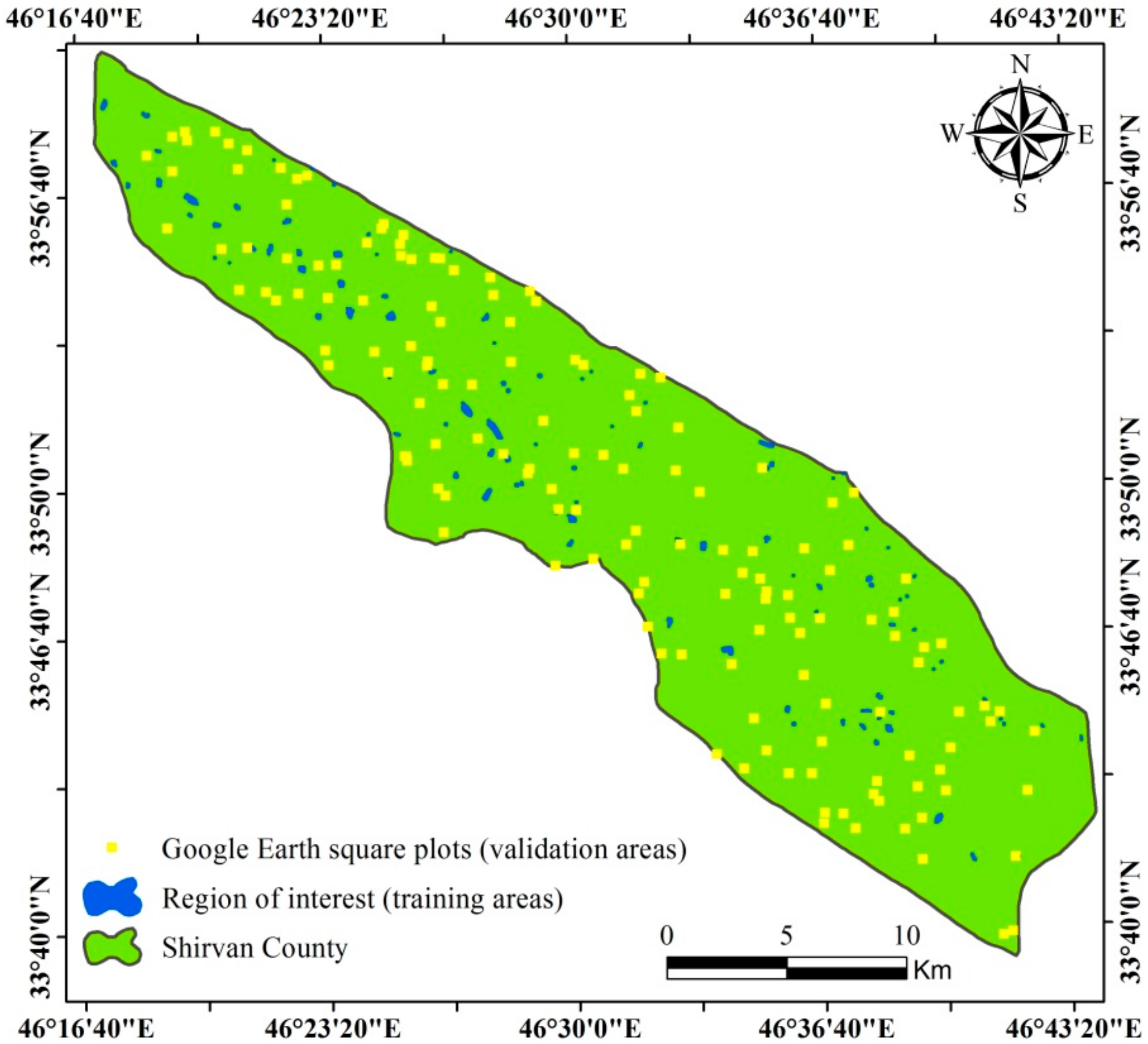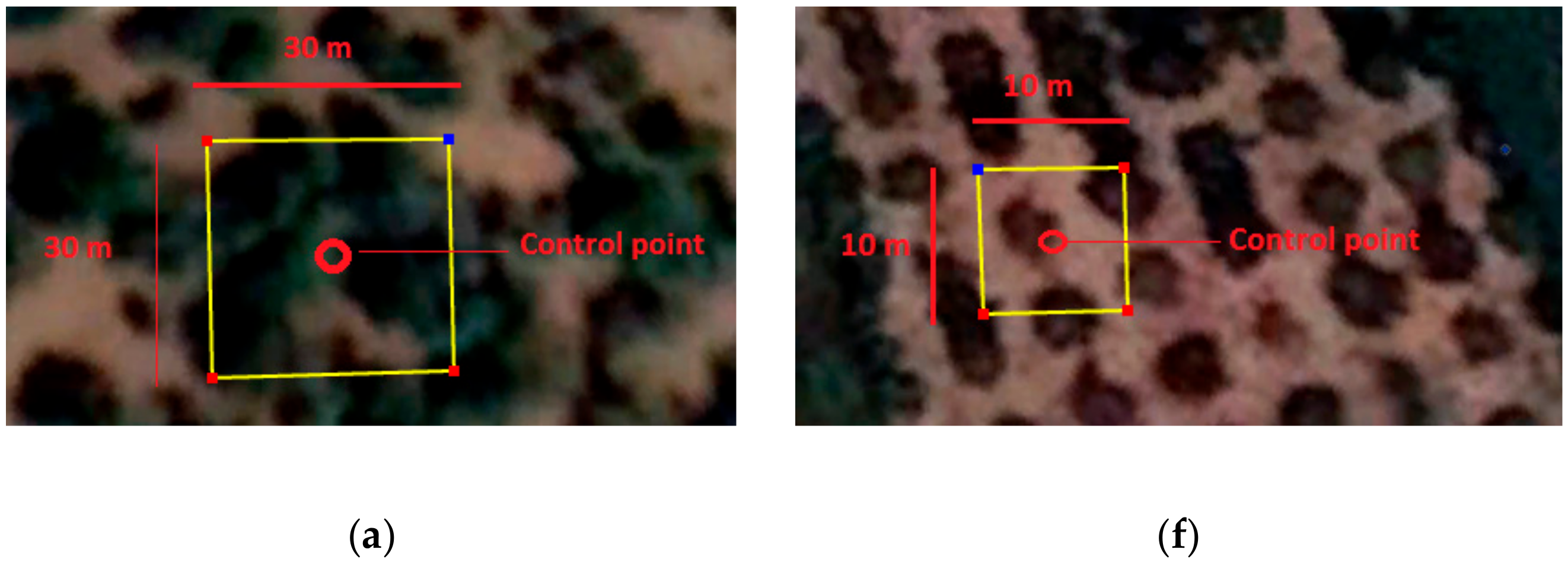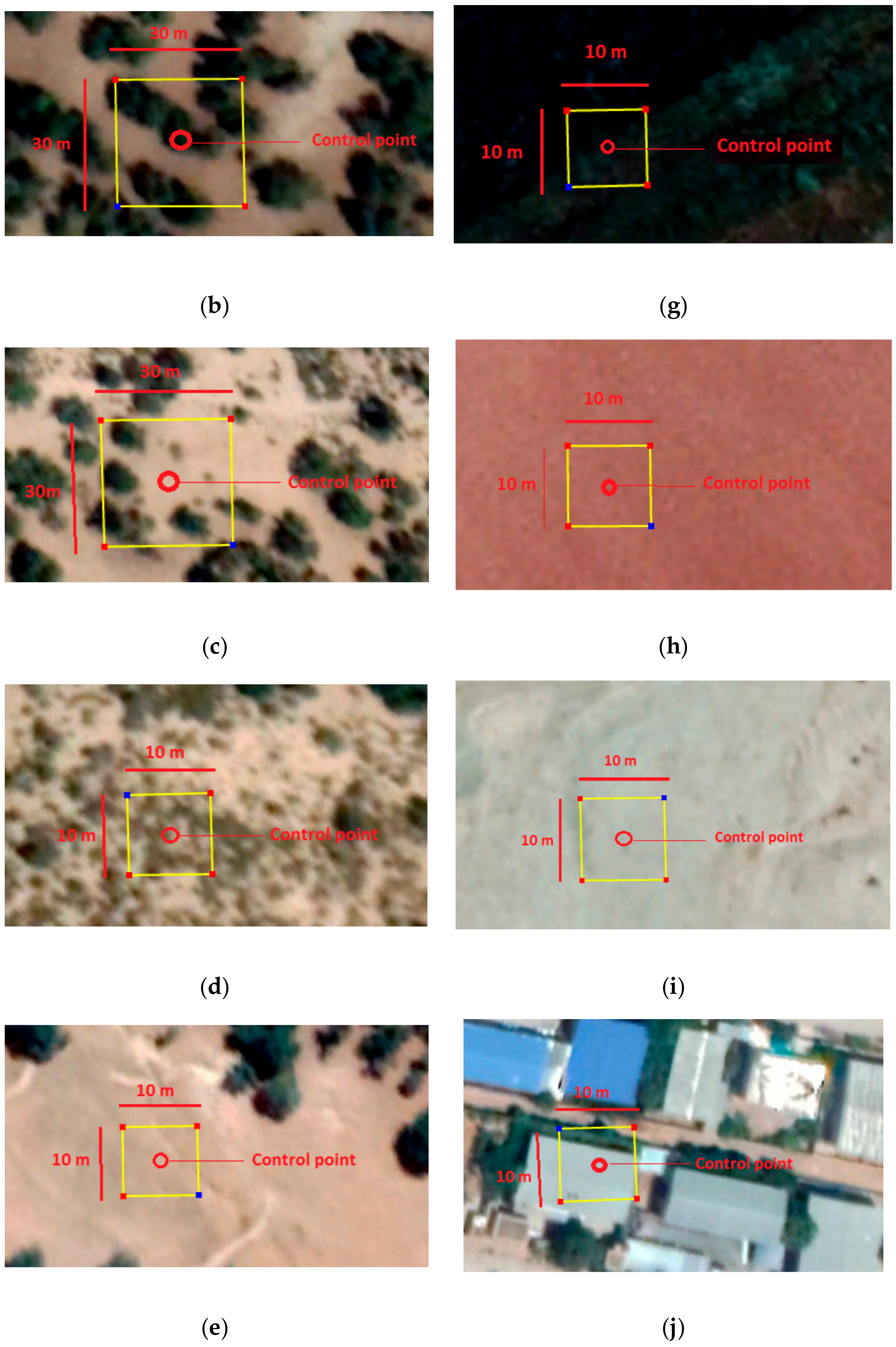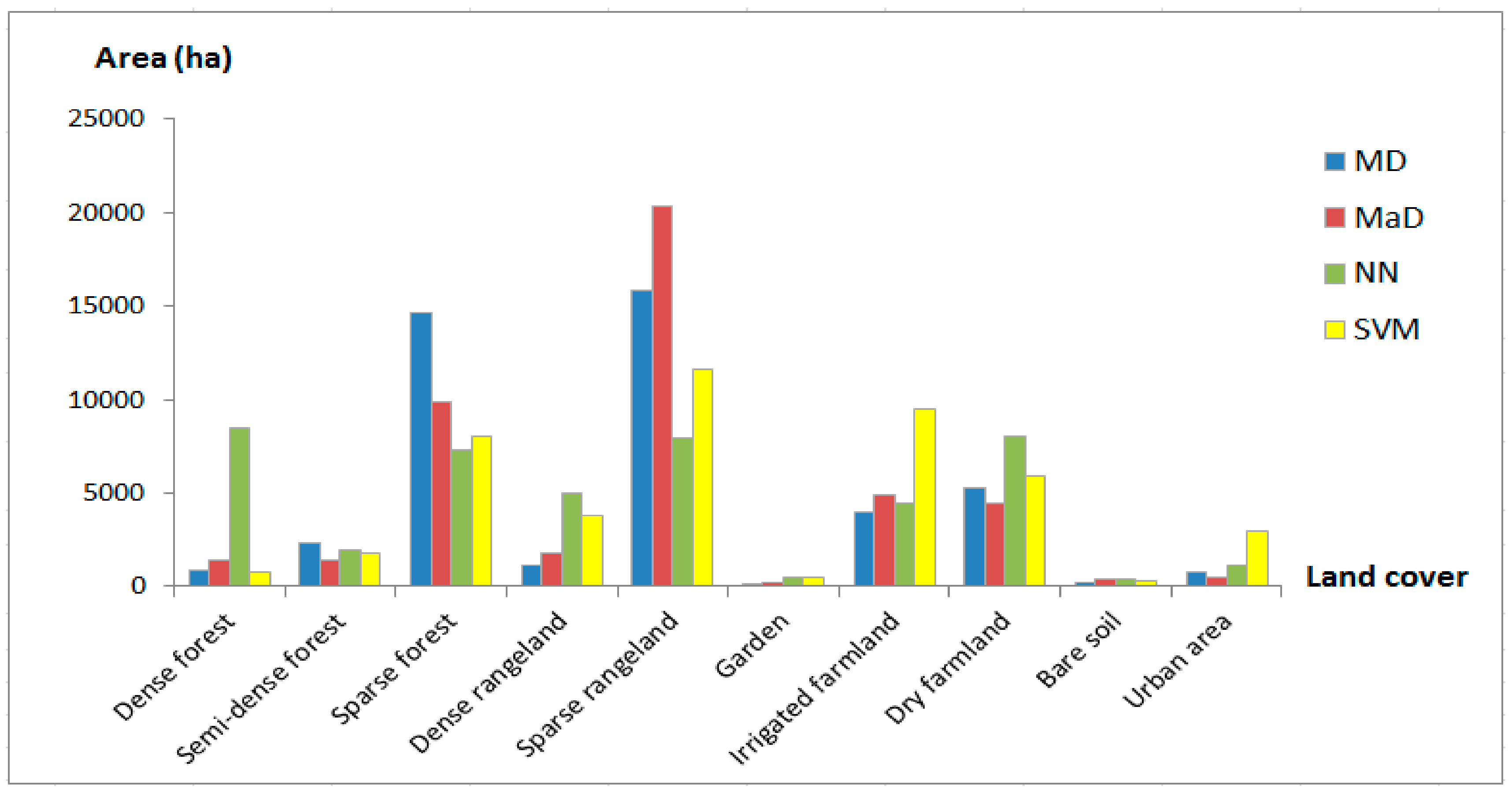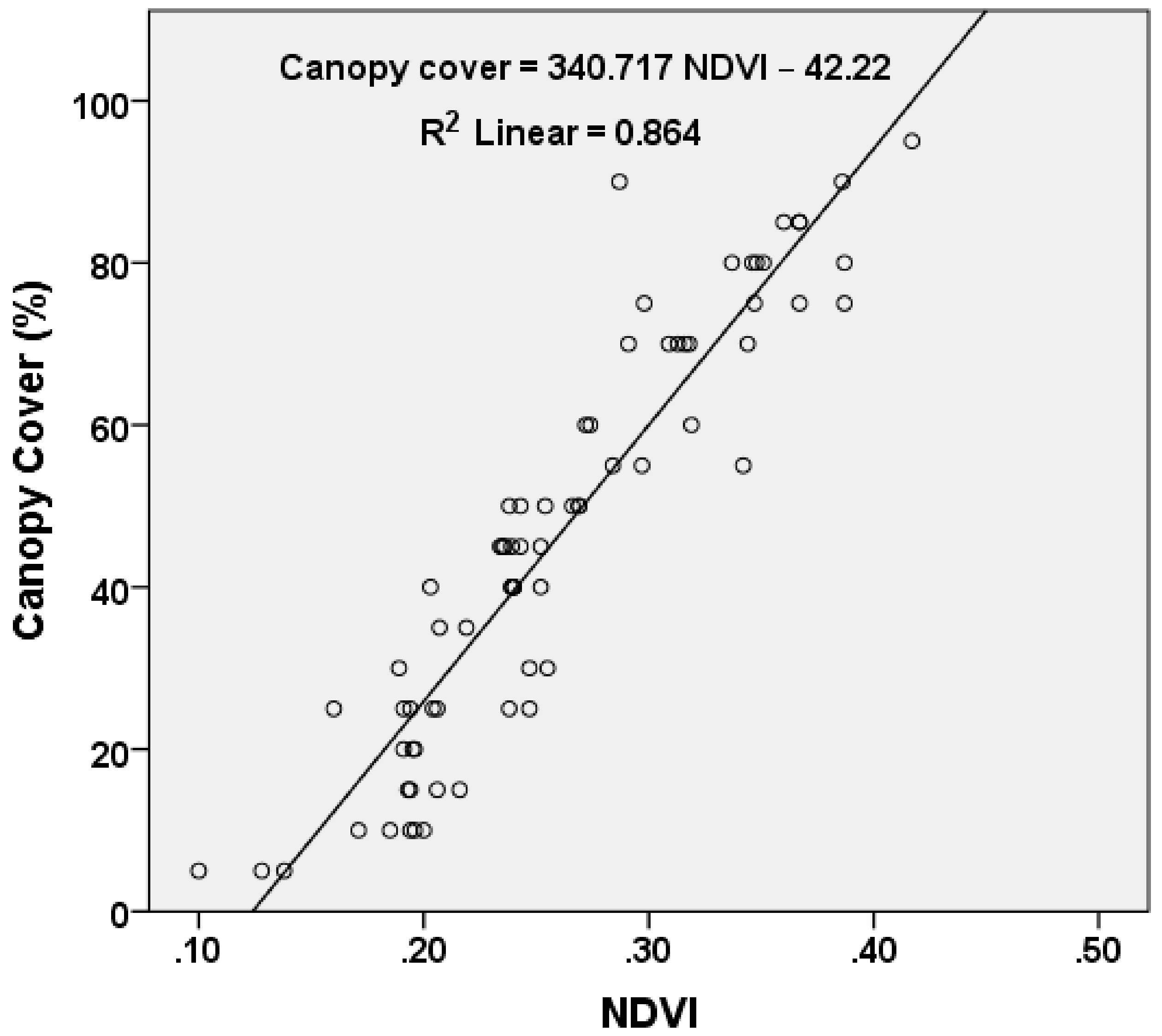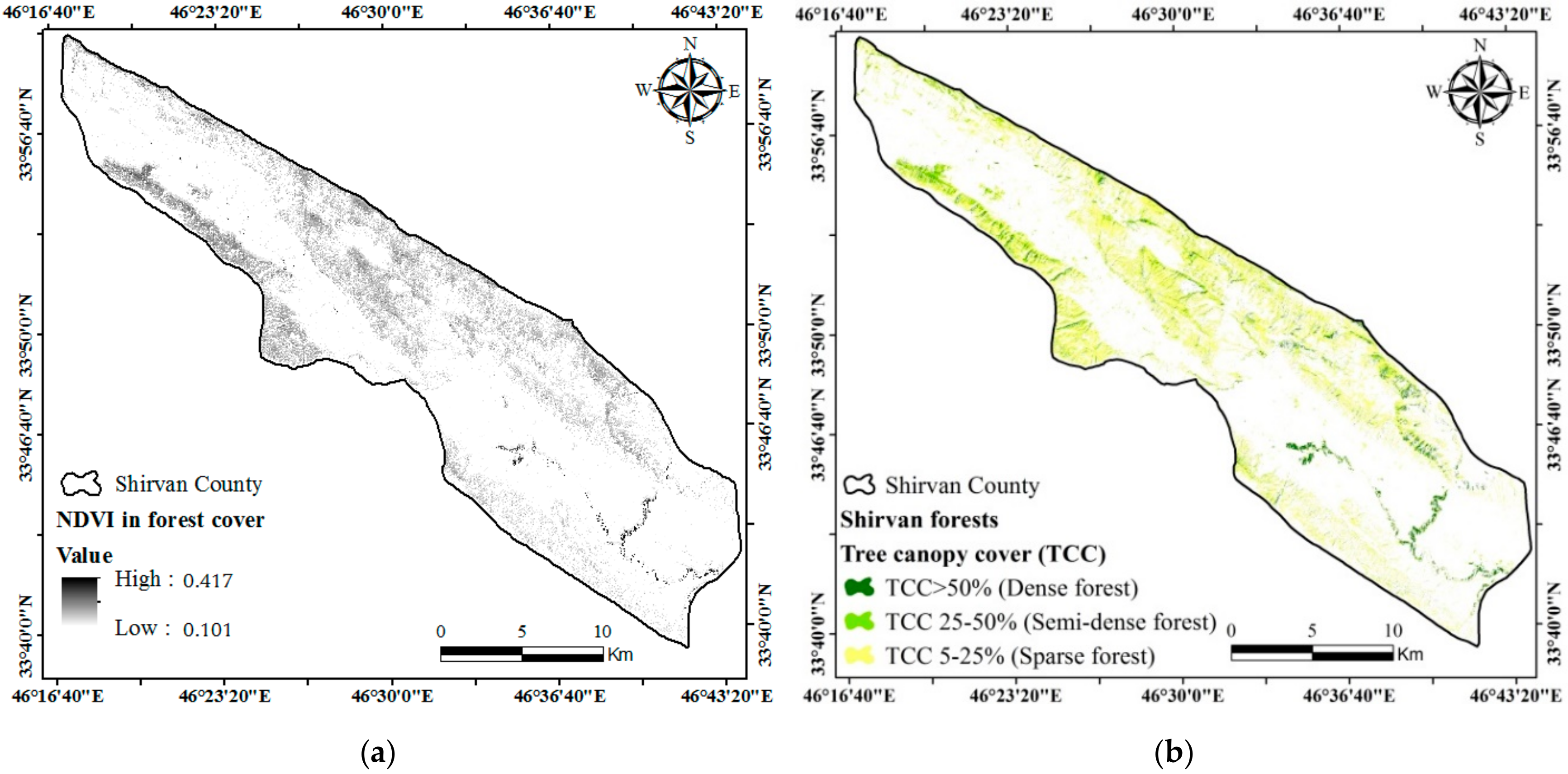1. Introduction
Iran is a vast country with different types of climate and vegetation, a wide range of elevation, and varied geological formations, the combination of which led to having rich biological diversity [
1] and numerous endemic species [
2]. The Zagros forests of Iran on Zagros Mountain extend from the northwest to the southwest of the country, making it the regional habitat with a large concentration of fauna and flora [
2,
3,
4]. Although the Zagros Mountain is not the most bio-diverse region in Iran, the Zagros oak forests are one of the most important natural ecosystems in Iran, that are 5500 years old [
5,
6,
7,
8]. Besides, these forests have an essential role in soil and water conservation in the Zagros Mountains in western Iran [
9]. Over the last 30 years, climate change, population growth, and the dependence of people’s livelihoods on these forests (by harvesting the wood and forest sub-products, converting forests to the agricultural lands, and grazing) have resulted in degradation of these natural ecosystems [
9,
10]. These forests, especially in Ilam Province in Western Iran, have been damaged by climate change, droughts (especially in oak forests), fires and human interference through, for example, the dependence of the residents on these areas for the provision of wood for fuel and land for livestock, agriculture, and grazing [
9,
10,
11,
12]. The biodiversity, ecosystem services, and economical production of the Zagros forests also suffered due to the lack of a management plan for these forests [
12,
13]. On the other hand, despite the high environmental value of these forests, there is not a comprehensive plan for the conservation of these forests on the national scale. Therefore, having accurate maps of the Zagros forests (area, density, and distribution) of Iran will be very useful in helping to detect the loss or gain process of these forests. Providing accurate maps of Zagros forests faciliates the effective management of these forests [
14]. For example, providing a precise land cover map in Zagros forests would help the managers of the natural resources to find the answers to questions such as (1) how natural and human-made land covers are distributed in the Zagros forest, (2) how large the exact area of different land covers inside Zagros forests is, or (3) how human-made land covers interact with the natural land covers (forests and rangelands). Additionally, providing an accurate forest cover map including different density classes would guide the forest managers to analyze (1) where the Zagros forests are distributed, (2) how much the exact area of Zagros forests in western Iran is, or (3) how the forest cover is disaggregated in different density classes. Therefore, providing land cover and forest canopy cover maps in these forests will be the first step to protecting them and preventing further destruction [
15].
Remote sensing data is an excellent source for mapping, monitoring, and understanding the land cover changes because of its synoptic, multi-spectral, and multi-temporal nature [
14,
15,
16,
17]. Satellite images have been widely applied for land use/land cover mapping in different areas around the world, such as in Brazil [
18], India [
19], and Turkey [
20]. Landsat-8 and normalized difference vegetation index (NDVI) have been used to estimate the tree species diversity in the savannah woodland of southern Africa [
21] and mapping the tree canopy cover (TCC) in the south of Ouagadougou in central Burkina Faso [
22] and semi-arid forests of the Sahel [
23]. At a coarser spatial resolution, the moderate resolution imaging spectroradiometer (MODIS) imagery allowed the land cover mapping in other countries such as India, Germany, and Pakistan [
24,
25,
26]. IRS data was also used for land cover mapping in some regions around the world [
27,
28,
29]. In recent years, Sentinel-2 satellite image data has proven very useful for land use/land cover mapping [
30,
31,
32,
33], achieving superior results for this purpose by applying the support vector machine (SVM) algorithm [
30,
33]. In the case of forest monitoring and management, Sentinel-2 images have successfully performed tree cover mapping [
34], tree species mapping [
35], vegetation mapping [
36], forest type mapping [
37], forest succession [
38], forest decline [
39], quantitative estimation of biophysical variables [
40], and estimation of defoliation of needle-leaf stands [
41]. The results of these studies have shown that the SVM algorithm has led to high accuracies for vegetation mapping and forest monitoring [
36,
41].
Regarding forest density and canopy cover mapping, vegetation indices have been widely used to estimate vegetation density or canopy cover mapping in forest areas. Pereira et al. [
42] used Landsat TM imagery and fieldwork data to determine the canopy cover percentage in Mediterranean shrublands. They obtained the best results when using the NDVI to estimate the canopy cover percentage (r
2 = 0.65). Oliveira [
43] used field radiometry and Landsat TM imagery to estimate several shrub parameters in the Alto-Dao region in Portugal. Field radiometry results showed that the NDVI was a vegetation index with high performance (r = 0.75). Calvao and Palmeirim [
44] collected field data of Mediterranean shrublands and developed correlations between several biophysical parameters and spectral variables (single channel reflectance and NDVI) from Landsat TM data. The higher correlation for canopy cover was obtained with TM band 3 (r = −0.91) and NDVI (r = 0.91). Karlson et al. [
22] used the NDVI from the WorldView-2 and Landsat-8 image to partition a woodland landscape in Burkina Faso into three classes based on the tree canopy cover density. Results showed that the dry-season NDVI and other spectral and textural characteristics were the most important factors in tree canopy cover mapping in the study area. Mohamed [
23] mapped the tree canopy cover in the semi-arid Sahel using Landsat-8 and Google Earth imagery. The developed method utilized the NDVI as the predictor variable coupled with estimations of tree canopy cover from Google Earth imagery as the response variable. The results showed a strong correlation (r
2 = 0.83) between the NDVI derived from Landsat 8 imagery and the TCC estimations from Google Earth imagery. Soares et al. [
45] mapped tree canopy cover changes in space and time in High Nature Value Farmland in southeast Portugal using aerial photography and Landsat images to prioritize reforestation efforts. The results showed that the dry-season NDVI was positively related to tree canopy cover changes, both across space and time. Barakat et al. [
46] used a supervised classification algorithm on Landsat-8 and NDVI to quantify the extent and density change of forest covers, crops, and bare soils in Morocco. The overall classification accuracy was 97.76% and 95.80% in 2001 and 2015 images, respectively. He adopted a method of thresholding the NDVI [
47] to highlight the density of each forest stand. Based on the NDVI values, the image was classified into three distinct thematic classes: NDVI < 0.1: without vegetation, 0.2 < NDVI < 0.4: slightly dense forest, and 0.4 < NDVI < 0.74: dense forest. The identification of the best-fitting threshold value was based on the comparison between the Google Earth images and the NDVI results. Chasmer et al. [
48] used the NDVI, simple ratio (SR), and soil adjusted vegetation index (SAVI) derived from a SPOT5 satellite image to estimate canopy cover. Their results indicated that the NDVI and SAVI are more comparable to canopy cover than other vegetation indices.
The results of several studies mentioned above have demonstrated that NDVI is the best vegetation index for estimating the tree canopy cover in different forest areas around the world [
22,
23,
40,
42,
43,
44,
45,
46,
47,
48,
49]. Besides, among different methods for predicting the relationship between TCC% and NDVI, linear regression has successfully been applied for this purpose. Many researchers have used linear regression to discover the relationship between the canopy cover and NDVI values in different areas around the world and have obtained acceptable results [
21,
23,
45,
50,
51].
Some studies in Western Iran have used different satellite images to perform land cover and forest cover mapping [
14,
52,
53,
54,
55]. Despite these studies, land cover and canopy cover mapping with Sentinel-2 satellite and Google Earth data, novel algorithms, and vegetation indices have not yet been performed in the Zagros forests. The extensive destruction of the Zagros forests in Western Iran in recent years [
12,
13,
14,
55,
56,
57,
58] necessitates comprehensive research for land cover mapping and evaluating the area, distribution, and density of these forests. Therefore, providing a new accurate land cover map and forest canopy cover map for the management of the Zagros forests is very important to preserve the biodiversity and ensure the conservation of endemic species. Although Cao et al. [
59] or Hansen et al. [
60] developed global land cover maps, their spatial resolution (30 m) is not sufficient to manage the endemic forests at the regional or national scale in Iran. In addition, the accuracy of these global maps for the Zagros ecosystem in Iran has not yet been assessed, and this global map may not be up-to-date for management purposes in the study area. Furthermore, we detected a gap regarding the information of tree canopy cover for this region. Previous studies demonstrated that a global tree canopy cover product has some obvious limitations, especially where the canopy cover is open [
61,
62,
63,
64].
This study aims to determine the method that adapts best to conditions in Western Iran (Shirvan County) for land cover and tree canopy cover mapping. This study focuses on answering the following questions: (1) Is Google Earth data helpful and accurate for land cover mapping in western Iran? (2) Is Sentinel-2 data able to produce an accurate land cover map in the highest spatial resolution for management purposes in mountainous Zagros forests of western Iran? (3) Which algorithm is the most accurate method for land cover mapping in the western forests of Iran for future applications? (4) Does NDVI, along with field data, provide a proper tool for tree canopy cover mapping in mountainous ecosystems of western Iran?
This study is the first application of Sentinel-2, Google Earth, and field data for land cover and tree canopy cover mapping in the study area as a part of the Zagros forests of Iran. We aim to provide a high spatial resolution (10 m) land cover and forest canopy cover maps that serve as the proper baseline to manage Zagros forests and to advance further the research of land cover and forest changes in the study area. The results of this research will be beneficial for Iranian forest managers in Forest, Rangelands, and Watershed Organization of Iran (FRWOI) to manage the land covers, especially forest cover in the study area. The forest managers in FRWOI need more detailed and up-to-date maps for effective management of the western mountainous forests in Iran. The paper provides an estimation of the different land cover type areas, as well as the distribution and density of the forests for future conservation planning.
5. Conclusions
This research presented an approach for mapping the land cover and tree canopy cover in western Zagros forests of Iran based on Sentinel-2, Google Earth, and field data. The results confirmed the possibility of producing an accurate 10 m resolution land cover and canopy cover maps exploiting easily accessible and free satellite data.
The accuracy assessment of Google Earth data using field data demonstrated that Google Earth data was reliable as reference data in this study. Assessing the accuracy of land cover maps using field data or other high-resolution data (WorldView, Quick bird, etc.) is very time-consuming or expensive. However, Google Earth data is freely available and reliable as reference data and could be used in similar studies in the future if the imagery is up to date.
When evaluating the performance of commonly used classification algorithms to produce a land cover map of Shirvan County using Sentinel-2 10 m bands, the SVM algorithm yielded the highest accuracy for land cover classification in our study area. The SVM algorithm adapted better to the limited input spectral information, the land cover classes, and the within-class variability compared to other commonly used methods such as the neural network classifier. Currently, there is no official report on the status of the land cover in Shirvan County. Therefore, the land cover map generated using the SVM algorithm in this study could be used as a baseline for FRWOI decision-makers to monitor land cover changes in the region, whether they be the result of human activities or natural events, and to establish a management plan of the preservation of the current natural land cover. The analysis of the land cover map obtained based on this algorithm showed that human land uses, such as irrigated farmland and dry farmland, cover a larger part of Shirvan County than the forested areas. The ancient oak forests of Shirvan County with 5500 years old are considered as one of the most important biodiversity hotspots of Iran where endemic and endangered species of fauna and flora converge. Therefore, effective environmental management and protection of these forests are required to control the pressure of human activities in these areas. Therefore, continuous and consistent land cover mapping of the study area using Sentinel-2 data will offer the FRWOI decision-makers and policymakers the information they need to protect the natural and cultural heritage of Shirvan County.
The results of this research demonstrated that the NDVI is a standard and reliable index for estimating the canopy cover based on some field data. Furthermore, the high reliability of the predictive model of the TCC% based on the NDVI means that this index could be very useful, especially for forest density mapping in mountainous landscapes like Western Iran, where accessibility to the forests is challenging. However, the reliability of this index should be further analyzed by collecting more field data for canopy cover estimation in future studies. The development of a model for the TCC% based on the NDVI in each province of the Western forests of Iran could be vital for the protective management of the whole Zagros forests in Western Iran.
